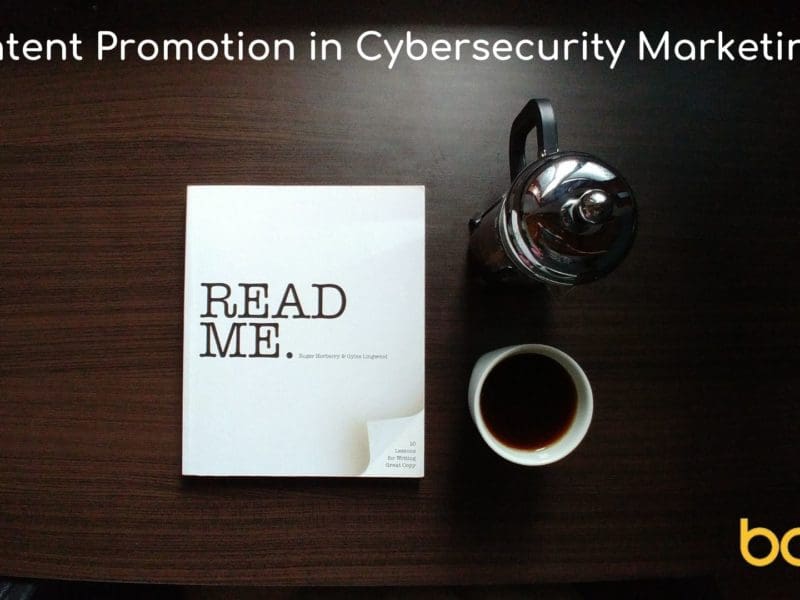In an age where data breaches and cybercrime make headlines regularly, it’s no wonder why security has become a hot topic.
Businesses sector-wide are looking to enhance their cyber defense strategies to mitigate risks and safeguard data. From firms in the highly regulated sectors of healthcare and finance to public and private sector institutions, companies worldwide are often turning to third-party cybersecurity specialists for proactive solutions and assistance, as they often lack vital in-house expertise or technical infrastructure.
B2B Cybersecurity Marketing Challenges
Cybersecurity firms everywhere recognize this gap in the market; businesses of all shapes, sizes, and geographies need specialist assistance that only a security provider can offer. This can range from upgrading to a more fit-for-purpose SOC to fortifying incumbent defenses with the help of highly technical specialisms such as vulnerability assessments, red teaming, and penetration testing.
Invariably, a cyber firm knows fully well that its diligent solutions will help bolster a business’s security resilience and reduce its threat exposure and attack surface. However, as is often the case with cybersecurity terminology, few people outside the realm genuinely understand it.
Therefore, cyber firms need to convey that experience and address their B2B audience’s pain points eloquently, authoritatively, and most importantly, in ways that their prospects can easily understand.
As a cybersecurity company director or marketer, you have a tremendous opportunity to demonstrate thought leadership, expertise, and authoritativeness that ‘cuts through the noise,’ so to speak. When assessing the competitive marketplace for cyber firms to stand out to prospective clients, content is one of the most effective assets they can have at their disposal.
Content helps solidify a cybersecurity provider as a go-to resource in the field, acting as both an educational and informational tool for businesses seeking knowledge and reassurance in a worrying threat landscape. Read the steps below to learn techniques for developing compelling and engaging cybersecurity content that grabs your audience’s attention and converts readers into leads and customers.
1) Know Your Audience and Their Pain Points
The foundation of an effective content strategy is understanding exactly who you are creating content for. Cyber firms can benefit greatly from creating detailed buyer personas of their ideal customers, including their roles, challenges, questions, and preferred content formats. This will require deep audience research and insight gathering.
For example, a cyber firm may have the infrastructure and resources to cater to companies of a specific size, and therefore, a target could materialize as an IT director or security operations manager. This type of individual may have all the insights a firm needs concerning operational systems, regulatory compliance, and industry standards and, therefore, may take the most influence from engaging cyber content.
Creating personas allows you to tailor content to your audience’s specific pain points. Understanding what they need assistance with can help your content’s messaging resonate more impactfully.
2) Convey Your Expertise with Educational Content
Your prospective clients will want to work with companies that genuinely understand their business (and sector) and can communicate complex topics with clarity and empathy.
Developing a knowledge base of educational articles, videos, eBooks, case studies, and more will help position your firm as a trusted expert in the field. If your prospects can see evidence of past solutions you have provided for similar companies in their sectors, you can immediately create a meaningful connection.
Suggest creating content that explains core concepts like encryptionWhat is Encryption?Encryption converts readable data (plaintext) into a scrambled and unreadable format (ciphertext) using an algorithm and a key. The primary purpose of encryption is to ensure the confidentiality..., phishingWhat is Phishing?Phishing is a type of cyberattack in which attackers send fraudulent communications, or direct people to counterfeit websites in order to trick those individuals into revealing sensitive information,..., malwareWhat is Malware?Malware, a portmanteau of "malicious software," constitutes a broad category of software specifically designed to infiltrate, damage, or disrupt computer systems, networks, and devices without the user's consent..., and secure web hosting. Bolster this with regulation-specific content on GDPRWhat is GDPR?The General Data Protection Regulation (GDPR) is widely regarded as the world's strictest security and privacy law, promulgated by the European Union (EU) to regulate any organization that..., ISO 27001, and PCI DSS and summaries or roundups of top emerging threats and security trends.
3) Mix High-Level Strategy and Actionable Advice
Another example of effective cybersecurity content combines top-level guidance with practical recommendations that readers can take on board immediately.
For instance, a blog entitled “Is Your Company Prepared to Handle a RansomwareWhat is Ransomware?Ransomware is a type of cyberattack in which the attacker infects a computer with malicious software that encrypts the victim's data. The computer usually becomes locked, presenting a... Attack?” could cover proactive planning to reduce risk exposure along with proactive response steps should they suffer such an attack.
Other similar ideas include email security checklists, top tips articles, FAQs, how-to guides, interviews, and analyst reports.
4) Strike an Urgent but Hopeful Tone
Many businesses are – rightfully – concerned about cyber-attacks, and it’s easy to feel helpless when reading about high-profile cases that have damaged reputations and left companies in financial ruin. The Deloitte Cyber Threat Intelligence Assessment for 2023 is enough to make even tech-savvy business owners feel a little disconcerted.
However, you can mitigate this by maintaining a hopeful, empowering, and confidence-instilling tone while still conveying the salient points about urgency and the need to maintain optimum security.
Mentioning attack statistics is helpful to drill home the key points, but what will translate more to readers is clear guidance on simple remediation steps that could reduce their attack surface, even marginally. Going a step further and providing thought-provoking video interviews and case studies will also reinforce key talking points with emphasis.
5) Leverage a Content Mix with Diverse Formats
Historically, thought leadership content has skewed towards long-format whitepapers and eBooks. While these assets remain useful for complex, detailed topics and deep analysis, modern buyers expect a diverse range of formats, including podcasts, blog posts, and infographics, among others.
It’s also important to remember the ever-dwindling attention spans of modern prospects in the digital space. Therefore, when it comes to creating thought-provoking content, it boils down to immediately capturing attention and making readers take notice. Text-based content is tremendously effective and versatile, but by all means, experiment with mediums beyond text.
6) Promote Your Content for Maximum Impact
Creating exceptional cybersecurity content for your intended audience and in the right formats is one thing. However, due to the competitive marketplace, this content could be ignored if it isn’t promoted correctly.
Promoting your content is crucial for driving engagement, awareness, and conversions. Consider the media you have created and identify the most impactful ways to dispense that content to more prospects, whether through email marketingWhat is Email Marketing?Email marketing may seem like an obvious route of notifying your audience of new releases, products, and services, however, it also serves a subtler function. It acts... and paid social media advertising or traditional PR and keynote speeches at conferences or trade shows.
Repurposing content by turning blog posts into videos or podcast transcripts into infographics (and vice versa) is excellent at reinforcing key messages. Identify the most relevant online communities on social media platforms where content can be shared to spark discussion and debate.
Don’t forget the importance of developing your website as a go-to resource for meaningful content. As with any marketing channel, look at the analytics carefully to isolate what is and isn’t working and adjust your content strategy accordingly.
The more exposure you drive through promotion, the better chance your content will land in front of the key decision-makers and people of influence you want to connect with.
7) Convert Readers into Leads with Calls-to-Action
One of the most glaring omissions from otherwise impeccable content is a meaningful call-to-action (CTA). This can turn casual content readers into viable sales leads by prompting them to take action, which can manifest in various ways.
A CTA could be:
- Downloading a PDF
- Requesting a software demo
- Booking a consultation
- Arranging a free quotation
- Subscribing to a newsletter or mailing list
CTAs should be placed strategically and methodically within and alongside content to break up long passages of text.
Test different CTA options from colors and formatting to placement and text. CTAs can be an effective conversion-boosting tool, but there is a risk of including too many and making your content overly promotional or ‘salesy.’ Find your ideal medium and use that to influence future content marketing decisions.
Following the above guidance will help your cybersecurity firm’s expertise and quality shine. As more businesses seek third-party specialist help navigating the complex digital terrain of today, the steps you take to solidify your authoritativeness will help you maintain long-term relationships and relevance in this space.




